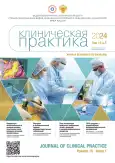Are there objective biomechanical symptoms of the knee instability after anterior cruciate ligament injury or it’s reconstruction
- Authors: Skvortsov D.V.1,2,3, Altukhova A.V.1, Kaurkin S.N.2,3, Akhpashev A.A.1
-
Affiliations:
- Federal Scientific and Clinical Center for Specialized Medical Assistance and Medical Technologies of the Federal Medical Biological Agency
- Pirogov Russian National Research Medical University
- Federal Center of Brain Research and Neurotechnologies
- Issue: Vol 15, No 1 (2024)
- Pages: 34-42
- Section: Original Study Articles
- URL: https://journals.rcsi.science/clinpractice/article/view/257935
- DOI: https://doi.org/10.17816/clinpract623681
- ID: 257935
Cite item
Full Text
Abstract
BACKGROUND: The instability of the knee joint after a rupture of the anterior cruciate ligament and even after its reconstruction remains a pressing problem. The use of a special functional test with fast walking can be considered as a potential tool for verifying this instability.
AIM: to observe the presence of biomechanical differences in the joint function with and without instability, both before and after the anterior cruciate ligament reconstruction.
METHODS: A biomechanical study of the function of walking at fast speeds, including an electromyographic study, was used. 40 patients were examined, of which 22 underwent reconstruction of the anterior cruciate ligament. The patients were divided into two groups — 33 patients with symptoms of instability, and 7 patients without them; the control group included 20 healthy persons.
RESULTS: The time characteristics of the step cycle did not reveal significant differences between the patient groups and the control group. For the amplitudes of movements in the joints, there were also no significant differences between the patient groups and between the affected and intact sides. The only finding was a significant increase in both amplitudes in the knee joint compared to the control for the intact side in the group with instability. The electromyographic study also did not reveal significant differences.
CONCLUSION: The use of a functional test with fast walking does not allow differentiating the state of instability. Thus, the instability of the knee joint during normal walking, even at a high speed, does not manifest itself in any way. To detect it, it is necessary to develop special provocative tests.
Keywords
Full Text
##article.viewOnOriginalSite##About the authors
Dmitry V. Skvortsov
Federal Scientific and Clinical Center for Specialized Medical Assistance and Medical Technologies of the Federal Medical Biological Agency; Pirogov Russian National Research Medical University; Federal Center of Brain Research and Neurotechnologies
Author for correspondence.
Email: dskvorts63@mail.ru
ORCID iD: 0000-0002-2794-4912
SPIN-code: 6274-4448
MD, PhD, Professor
Russian Federation, Moscow; Moscow; MoscowAlyona V. Altukhova
Federal Scientific and Clinical Center for Specialized Medical Assistance and Medical Technologies of the Federal Medical Biological Agency
Email: altukhova.aa@bk.ru
ORCID iD: 0000-0003-3777-6294
Research Associate
Russian Federation, MoscowSergey N. Kaurkin
Pirogov Russian National Research Medical University; Federal Center of Brain Research and Neurotechnologies
Email: kaurkins@bk.ru
ORCID iD: 0000-0001-5232-7740
SPIN-code: 4986-3575
MD, PhD
Russian Federation, Moscow; MoscowAlexander A. Akhpashev
Federal Scientific and Clinical Center for Specialized Medical Assistance and Medical Technologies of the Federal Medical Biological Agency
Email: akhpashev@gmail.com
ORCID iD: 0000-0002-2938-5173
SPIN-code: 9965-1828
MD, PhD
Russian Federation, MoscowReferences
- 1016/j.jelekin.2004.03.002
- Hurd WJ, Snyder-Mackler L. Knee instability after acute ACL rupture affects movement patterns during the mid: Stance phase of gait. J Orthop Res. Author manuscript; available in PMC 2010 Apr 26. Published in final edited form as: J Orthop Res. 2007;25(10):1369–1377. doi: 10.1002/jor.20440
- Bohn MB, Petersen AK, Nielsen DB, et al. Three-dimensional kinematic and kinetic analysis of knee rotational stability in ACL-deficient patients during walking, running and pivoting. J Exp Orthop. 2016;3(1):27. doi: 10.1186/s40634-016-0062-4
- Schmitt LC, Rudolph KS. Muscle stabilization strategies in people with medial knee osteoarthritis: The effect of instability. J Orthop Res. 2008;26(9):1180–1185. doi: 10.1002/jor.20619
- Schrijvers JC, van den Noort JC, van der Esch M, Harlaar J. Neuromechanical assessment of knee joint instability during perturbed gait in patients with knee osteoarthritis. J Biomech. 2021;118:110325. doi: 10.1016/j.jbiomech.2021.110325
- Schrijvers JC, van den Noort JC, van der Esch M, et al. Objective parameters to measure (in) stability of the knee joint during gait: A review of literature. Gait Posture. 2019;70:235–253. doi: 10.1016/j.gaitpost.2019.03.016
- Winter DA. The biomechanics and motor control of human gait: normal, elderly and pathological. Waterloo, Ontario: University of Waterloo Press; 1992.
- Hermens HJ, Freriks B, Disselhorst-Klug C, Rau G. Development of recommendations for SEMG sensors and sensor placement procedures. J Electromyogr Kinesiol. 2000;10(5):361–374. doi: 10.1016/s1050-6411(00)00027-4
- Stoelben KJ, Pappas E, Mota CB. Lower extremity joint moments throughout gait at two speeds more than 4 years after ACL reconstruction. Gait Posture. 2019;70:347–354. doi: 10.1016/j.gaitpost.2019.02.025
- Goetschius J, Hertel J, Saliba SA, et al. Gait Biomechanics in anterior cruciate ligament-reconstructed knees at different time frames postsurgery. Med Sci Sports Exerc. 2018;50(11): 2209–2216. doi: 10.1249/MSS.0000000000001693
- Skvortsov D, Kaurkin S, Akhpashev A, et al. Gait analysis and knee kinematics in patients with anterior cruciate ligament rupture: Before and after reconstruction. Appl Sci. 2020; 10(10):3378. doi: 10.3390/app10103378
- Gardinier ES, Manal K, Buchanan TS, Snyder-Mackler L. Gait and neuromuscular asymmetries after acute anterior cruciate ligament rupture. Med Sci Sports Exerc. 2012;44(8):1490–1496. doi: 10.1249/MSS.0b013e31824d2783
- Garcia SA, Brown SR, Koje M, et al. Gait asymmetries are exacerbated at faster walking speeds in individuals with acute anterior cruciate ligament reconstruction. J Orthop Res. 2022;40(1):219–230. doi: 10.1002/jor.25117
- Creaby MW, Bennell KL, Hunt MA. Gait differs between unilateral and bilateral knee osteoarthritis. Arch Physical Med Rehab. 2012;93(5):822–827. doi: 10.1016/j.apmr.2011.11.029
- Ismailidis P, Hegglin L, Egloff C, et al. Side to side kinematic gait differences within patients and spatiotemporal and kinematic gait differences between patients with severe knee osteoarthritis and controls measured with inertial sensors. Gait Posture. 2021;84:24–30. doi: 10.1016/j.gaitpost.2020.11
Supplementary files






